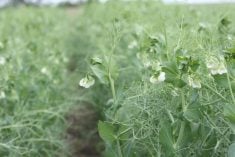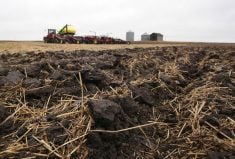U.S. Department of Agriculture study finds that a no-till wheat and pea rotation is the most environmentally sustainable
WINNIPEG — American scientists have confirmed what Canadian farmers already know — zero tillage is good for the environment and for crop production.
U.S. Department of Agriculture researchers looked at the long-term effects of three cropping rotations in Montana — summer fallow-wheat, no-till continuous wheat and no-till wheat-pea.
After crunching the data, they concluded that the wheat-pea rotation is the most sustainable.
Read Also

Short rapeseed crop may put China in a bind
Industry thinks China’s rapeseed crop is way smaller than the official government estimate. The country’s canola imports will also be down, so there will be a lot of unmet demand.
“No-till continuous spring wheat and no-till spring wheat-pea reduced greenhouse gas emissions per unit area, as well as per unit crop yield compared to continuous till spring wheat-fallow, due to increased carbon sequestration,” says the study, published late September in the Journal of Environmental Quality.
The researchers also found that continuous wheat causes disease issues and cuts into yields over time.
“For sustaining long-term crop yields and reducing GHG emissions, NTWP (no-till wheat pea) may be recommended as an ideal dryland cropping system in the semiarid condition of the U.S. northern Great Plains.”
The finding isn’t a shock, considering field peas require less fertilizer, and zero tillage has a proven track record of reducing soil erosion and enhancing the health of the soil.
However, the USDA scientists also quantified the environmental benefits of reduced tillage and the environmental consequences of summer fallow.
The researchers studied the three dryland cropping systems at the USDA centre in Sidney, Montana, looking at data that stretches back 34 years.
They collected nitrous oxide and methane emissions from the cropland throughout the year, from 2012-19. They also estimated the carbon sequestration rates of the three rotations.
Using the emissions data and sequestration rates, the scientists calculated the net greenhouse gas emissions from the cropland.
“Overall, the no-till continuous cropping systems reduced net GHG balance by 66 to 149 percent compared to the conventional till crop-fallow system,” they said.
Of note, the no-till continuous wheat (NTCW) had a higher amount of carbon sequestration when compared to the no-till wheat pea rotation.
“(The) slower decomposition of crop residue due to higher C/N (carbon/nitrogen) ratio of spring wheat residue compared to pea residue probably increased soil organic carbon for NTCW compared to NTWP (no till wheat-pea).”
The scientists learned that continuous wheat increased pest pressure and soil acidity from the annual applications of fertilizer compared to the wheat-pea rotation.
Those agronomic issues reduced wheat yields and the return on investment for growers.
The USDA study on the sustainability benefits of no till and having a legume in the rotation is similar to the findings of a report from the University of Saskatchewan.
In January, the Global Institute for Food Security at the U of S concluded that Saskatchewan farmers are producing crops with relatively low emissions when compared to growers in Australia, Europe and the United States.
“The results are driven by the widespread adoption in Saskatchewan of agricultural innovations and sustainable farming practices that have significantly reduced the amount of inputs and emissions needed to farm each acre of land,” said Steve Webb, chief executive officer of the Global Institute for Food Security.
“The sustainable practices include reduced tillage, the adoption of herbicide-tolerant canola, the variable-rate application of fertilizer, a robust crop rotation system and the production of nitrogen-fixing pulse crops.”
















